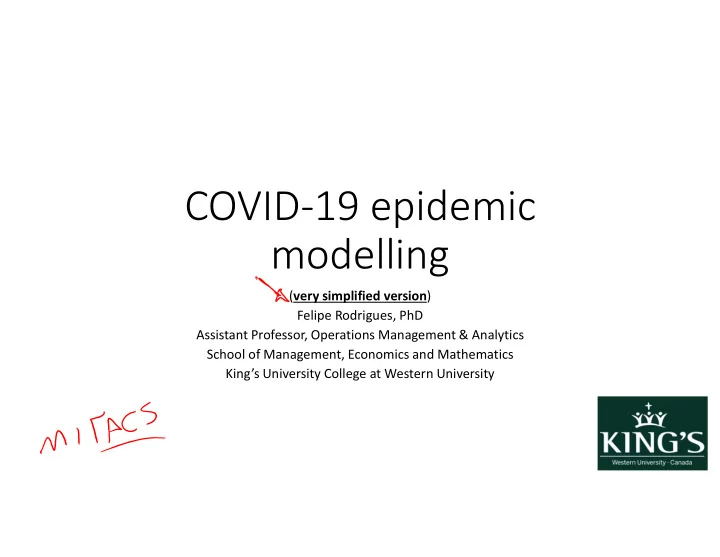

COVID-19 epidemic modelling ( very simplified version ) Felipe Rodrigues, PhD Assistant Professor, Operations Management & Analytics School of Management, Economics and Mathematics King’s University College at Western University
Agenda • Introduction • Epidemiologic Modelling • At risk populations, epidemiology toolbox • Case for Ontario • Questions
Introduction • Pandemics are scary • Health, economic implications • Quarantine, social distancing cannot last forever (?) • Flattening the curve -> “communication problem” • Epidemics are well behaved mathematically if you make the proper assumptions and have the reasonable parameters:
The “Susceptible-Infected-Removed” model (SIR) Key parameter: • is the “basic reproduction number” • The “R-zero”, “R-naught” • is a measurement of the force of infection • # contacts * prob of transmission • is the infections period • ,
The “Susceptible-Infected-Removed” model (SIR) S (Susceptible) I (Infected) R (Recovered, Removed) • Change in S in one unit of • Change in I in one unit • Change in R in one unit of time of time time • 𝑱 � = −𝑻 � − 𝑺′ • 𝑺 � = 𝜹 𝑱 𝑻 • 𝑻 � = − 𝜸 𝑱 𝑶 • S’: change in number of • γ: recovery rate (the • 𝛾 : # contacts x prob susceptible inverse is the time to transmission recovery) • γ: recovery rate (the • I: # Infected inverse is the time to • I: # infected recovery) • S: # Susceptible • N: Total Population • I: # infected
The “Susceptible-Infected-Removed” model (SIR) – Building intuition
SIR Model
Implications • Flattening = spreading infection over time…there will still be the infection and will take time • ICU beds need to be used by people with strokes, cardiac arrest, invasive surgeries, cancer, etc… • When will it be safe to go outside?
Ontario – patient “zero”
Ontario – reasonable assumptions, no quarantine
Ontario – effective intervention measures
Projected critical care demand with reductions in physical distancing effort 50% reduction in contacts 55% reduction in contacts 75% of population reduces contacts 75% of population by 75% reduces contacts by x% 60% reduction in contacts 75% reduction in contacts March 1 Cipriano, Haddara, Zaric, 2020
How does Modelling and forecasting help?
Community may cycle through levels of SD intensity Ward hospitalizations Critical care Scenario Physical distancing participation Participation in community physical distancing decreases 1.5% per day (to min of 40%) when hospital capacity < 45 beds Participation in community physical distancing increases 1.5% per day (to max of 75%) after hospital capacity > 45 beds March 1 Cipriano, Haddara, Zaric, 2020
Community engagement affects need for hospital resource endurance Ward hospitalizations Critical care Scenario Physical distancing participation Participation in community physical distancing decreases 1.5% per day (to min of 40%) when hospital capacity < 45 beds Participation in community physical distancing increases 1.5% per day (to max of 65%) after hospital capacity > 45 beds March 1 Cipriano, Haddara, Zaric, 2020
Preparing for Uncertainty Just in Time vs Just in Case Cipriano, Haddara, Zaric, 2020
Preparing for Uncertainty Just in Time vs Just in Case Cipriano, Haddara, Zaric, 2020
Questions? Felipe Rodrigues, PhD frodrig7@uwo.ca Assistant Professor, Operations Management & Analytics School of Management, Economics and Mathematics King’s University College at Western University
Recommend
More recommend